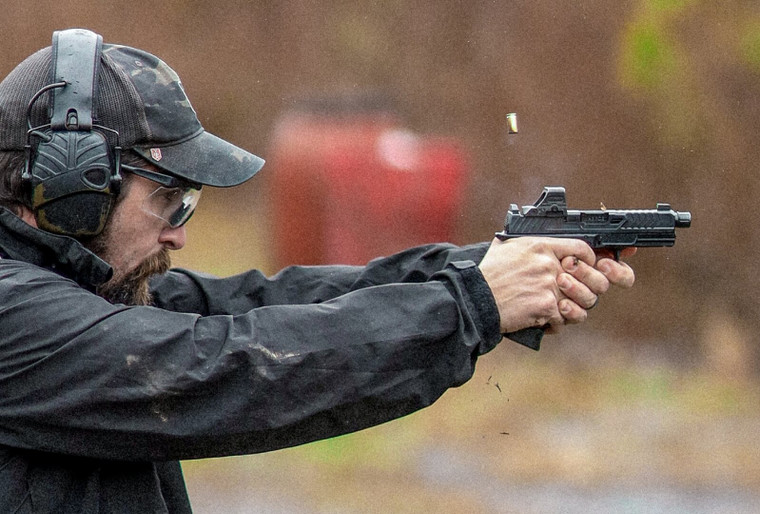Beyond the Gun: Developing the Skills and Mindset Every Concealed Carrier Needs
Posted by Warrior Poet Society on Aug 15th 2025
If you carry a firearm—or ever plan to—you need to understand something vital: simply owning a gun doesn’t make you safe, ready, or capable.
Carrying concealed comes with immense responsibility. Most people check the first box—buying the firearm—and then falsely assume they’re prepared for any dangerous encounter. But real-world violence isn’t clean, slow, or predictable. Bad guys are ambush hunters. They strike without warning, and if you’re well trained, you’ll have better odds of coming out on top.
I’m going to walk you through the big picture of defensive pistol development: from your first purchase to advanced tactics involving psychology and deception. And yes, there’s some range work included, but the deeper takeaway is how to think and train like a protector.
Step 1: Buy the Right Gun
You’ll make your own decision, but if you’re asking for a recommendation, start with a Glock or one of our War Poet pistols from Shadow Systems:
• Glock 19: Great all-around fighting option for midsize carry.
• Glock 43 or 43X: Better for deep concealment with a thinner profile.
• Shadow Systems War Poet: If you’re looking for a complete “ready to fight” package right out of the box, take a serious look at the War Poet pistols on which we collaborated with Shadow Systems.
We’ve decked out these guns with all sorts of goodies from compensators to triggers, and red dots to threaded barrels. These are legit and have my full thumbs up.
⁃ Subcompact: CR920/CR920P War Poet (smallest Glock 43/43X size)
⁃ Compact: MR920 War Poet (Glock 19 size)
⁃ Full size: DR920 War Poet (Glock 17 size)
Buy what you want. Then, once you learn what you didn’t know, you might wish you’d taken this advice. But hey, that’s part of the process.
Shop the War Poet pistol family here.
Step 2: Get Initial Training
Owning a gun is the beginning, not the goal. Learn how to shoot it accurately and consistently. Hitting a wall-size target doesn’t count. You should be able to hit small, deliberate points of aim reliably. That kind of control is what solidifies your fundamentals.
Step 3: Build Your Draw-stroke
Once you’ve nailed your fundamentals, move into draw-stroke work:
• From a holster
• Off a nightstand
• Out of a purse
• From concealment
Speed becomes a factor here, but only after control and consistency are in place. Don’t rush here, I mean it. Click here to read my post about mastering your draw.
Step 4: Learn to Shoot While Moving
Shooting on the move gives you a major tactical advantage if you can do it while maintaining accuracy. It also helps you become a harder target to hit.
Moving offline, breaking the traditional “stand-and-fire” posture, is a game-changer in dynamic threat situations. This is where I recommend getting higher levels of training like our Pistol 3 and Rifle 3 courses.
Step 5: Master the Human Element
This is where things get advanced and often overlooked.
Violent encounters aren’t competitions. You’re not fighting the timer on a range. You’re facing another human being who wants to hurt or kill you.
That means you must understand and train for psychology.
Most shooters telegraph their intentions. They tense up. Their eyes harden. Their body says, “I’m about to attack.” But in a real encounter, this could get you killed.
What should you do instead?
Deception. Surprise. Confusion.
• Feign compliance. Say things like, “I’m not a threat,” “I give up,” or “Please don’t shoot me.” Let the threat think they’re in control.
• Then explode into action. When the moment is right, act with speed, aggression, and precision. If they never saw it coming, they won’t be able to stop it.
This tactic buys you time, creates doubt in the attacker’s mind, and gives you a fighting chance.
A Word of Caution
This level of training is not for beginners. You cannot and should not attempt these tactics without a successful history and foundation in:
• Proper training
• Safety protocols
• Repetition under pressure
What you may see in our videos has been practiced and mastered over hundreds, if not thousands, of repetitions. Every movement, every safety check, every motion has been hardwired through deliberate training. The draw-stroke is a scientific process, not a freestyle performance.
If you skip the basics and jump into advanced tactics, you’re more likely to hurt yourself or someone else than stop a threat.
The Bottom Line
• Buy the right gun.
• Learn to shoot it well.
• Train your draw.
• Add movement.
• Understand psychology.
• Never stop learning.
This isn’t about being tactical for the sake of looking cool. This is about staying alive, protecting others, and being ready when it counts.
Remember, Train hard. Train smart. Train safe.
Check out Warrior Poet Society Network for an extensive online library of expert firearms training, on demand on any of your devices.

